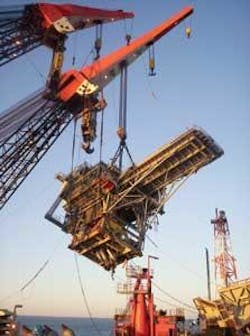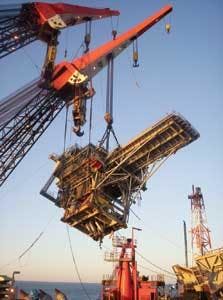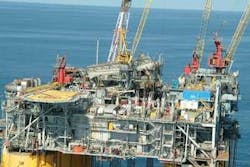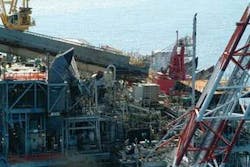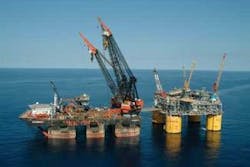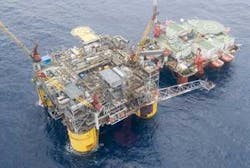Shell restarts Mars TLP, includes industry firsts
David Paganie, Senior Editor
Production at Shell’s Mars TLP, the largest producing platform in the Gulf of Mexico, resumed on May 22, 2006 after undergoing a series of repairs to its damaged platform rig and export pipelines. It had been shut-in due to damage from Hurricane Katrina since late August of last year.
Shell workers and contractors experienced a number of industry firsts while restoring production at the TLP. Meanwhile, as a result of the platform rig’s failure to withstand the hurricane force winds, Shell is undertaking a process to enhance the design of the clamps that holds the rig in place.
Three months of preparation, planning and work on-site led to the lift of the damaged 1,000-ton Mars platform rig in two pieces from its awkward toppled position on the platform deck. The damaged sections of the rig were transported to shore for repairs. The rig was removed without damaging the important high pressure gas treatment vessel that was under the rig; an accomplishment that helped to shorten the recovery time at Mars.
Pipeline repairs
Experienced engineers, construction specialists, technicians, and other support staff accomplished an industry-first deepwater pipeline project, successfully repairing the Mars oil and gas export pipelines in 2,700 ft of water, using underwater robotics to execute tasks normally performed by divers in shallow waters.
The pipelines were damaged as a result of a drifting semisubmersible drilling rig that dragged an anchor across the lines during Katrina. The 18-in. oil line and 14-in. gas line were both repaired and integrity testing was completed ahead of production restart.
In addition, the Mars flexjoint (the pipeline connection to the TLP) repairs, scheduled prior to the 2005 hurricane season but delayed due to loop currents, were completed during the Mars recovery effort.
Shell says it always places the health and safety of its personnel as the highest priority in any effort. First and foremost, the evacuation of the Mars platform removed all personnel before Katrina approached, preventing any injuries.
The safety performance of the recovery team was another major success in this project - under particularly challenging circumstances. The Mars recovery effort tallied more than 1 million man-hours without a recordable injury. This is a remarkable accomplishment, according to Shell.
Shell mobilized and coordinated a team from multiple contractors around the world to safely execute the work needed to repair the platform. To accommodate the living quarters and deck area needed to perform the task ahead, Prosafe Offshore’sSafe Scandinavia journeyed from the North Sea to the Gulf of Mexico for the first time.
The six-story vessel with lodging for over 500 people deployed the Shell supplied deepwater mooring system in record water depth for this vessel. With the shortage of labor in the entire Gulf region, the company overcame a major challenge to secure a Cajun chef to join the catering staff on the accommodation vessel.
Lessons learned
While the Mars TLP structure and wells survived the extreme weather conditions with no damage, the platform’s drilling rig and some of the major elements of its production equipment and piping were heavily damaged.
Most of the damage was caused by the wind and sea conditions toppling the drilling rig mounted on the platform. As a result, Shell is designing an enhanced rig clamp system for platform rigs. Platform rigs are mounted on a skid system that allows them to move in two directions to be positioned over a well slot. Once in position, they are clamped to the skid beams. While the clamp system has worked well in the past, the conditions experienced from Katrina warrant revisions to the system.
The Mars oil and natural gas export lines were damaged as a result of a drifting semisubmersible drilling rig that dragged an anchor across the lines during the storm. As a result, Shell is participating in a Joint Industry Project (JIP) to develop more robust mooring systems and practices for offshore drilling rigs.
Additionally, industry metaocean data will be updated to reflect the severity of recent storms. This new data will result in enhanced design criteria for new structures.
